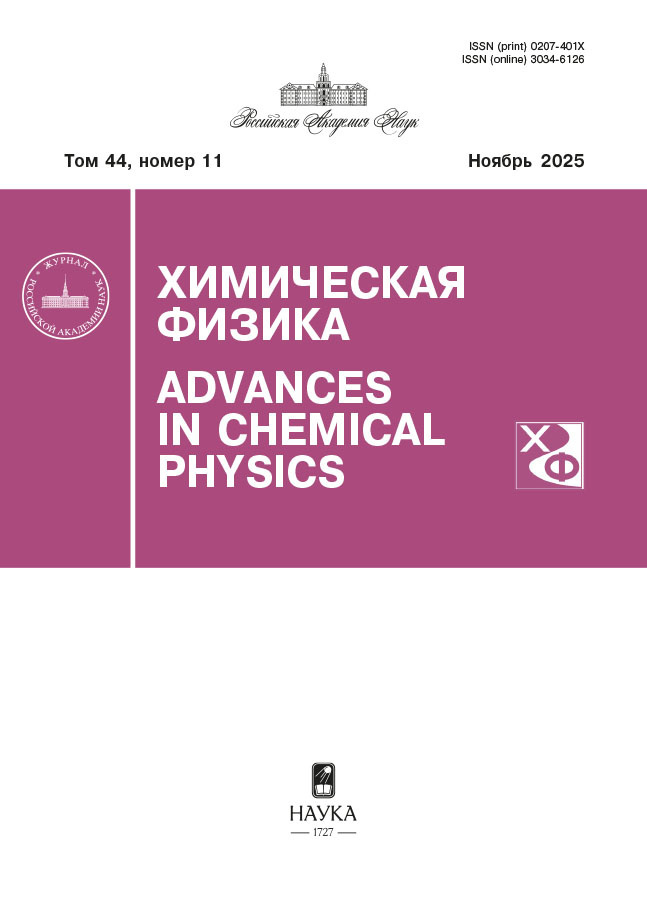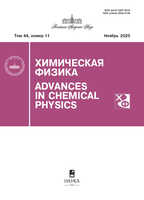Himičeskaâ fizika
ISSN(Print): 0207-401X
Media registration certificate: No. 0110275 dated 02/09/1993
Founder: Russian Academy of Sciences, Federal Research Center for Chemical Physics named after. N.N. Semenov RAS
Editor-in-Chief: Buchachenko Anatoly Leonidovich
Number of issues per year: 12
Indexation: RISC, list of Higher Attestation Commissions, CrossRef, White List (level 2)
The journal publishes articles on the following topics:
- elementary physical and chemical processes
- structure of chemical compounds, spectroscopy, quantum chemistry
- reactivity, influence of external fields and environment on chemical transformation
- molecular dynamics and molecular organization
- dynamics and kinetics of photo- and radiation-induced processes
- mechanism of chemical reactions in the gas and condensed phases and at interphase boundaries
- chain and thermal processes of ignition, combustion and detonation in gases, in two-phase and condensed systems
- shock waves
- physical methods for the study of chemical reactions
- biological processes in chemical physics
The journal is designed for researchers, graduate students and students specializing in the study of the kinetics and mechanism of chemical reactions, energy transfer processes, the structure of matter, catalysis, combustion and detonation processes, transformations in shock waves
The journal is designed for researchers, graduate students and students specializing in the study of the kinetics and mechanism of chemical reactions, energy transfer processes, the structure of matter, catalysis, combustion and detonation processes, transformations in shock waves.
Ағымдағы шығарылым
Том 44, № 11 (2025)
Электрические и магнитные свойства материалов
Piezoelectric properties of composite polymer materials based on PVDF
Аннотация
The paper examines composite polymer materials based on a PVDF matrix, which differ in filler material. Polyvinylidene fluoride (PVDF) is an organic polymer material with a significant piezoelectric effect. Currently, due to its physical and chemical properties, it is actively used for the development and creation of acousto-electronic devices, including sensors for various purposes, as well as in flexible electronics devices. Using Raman spectroscopy and dielectric spectroscopy methods, it is shown that the electrophysical properties of a composite material based on PVDF are determined by the formulation and manufacturing conditions. The additional polarization of the PVDF composite with various fillers in an external electric field directly during the creation of samples will significantly improve the electrophysical properties (coefficient of electromechanical coupling, dielectric constant). At the same time, the use of solid-state fillers significantly improves the mechanical and operational properties of such composites.
 3-8
3-8


Frequency dependencies of electrical characteristics of composite materials based on organosiloxanes and highly dispersed carbon fillers of various shapes
Аннотация
Composites based on siloxane with additives of hybrid filler in the form of a mixture of spherical and extended carbon structures frequency characteristics are studied by electrometrical method. The effect of the filler type and concentration on the conductive properties of the composites, as well as the behavior of electrical resistance during mechanical stretching, was determined. The introduction of a hybrid filler into the composite significantly changes the value and depending type of electrical conductivity.
 9-15
9-15


Microwave properties of magnetically structured composite materials based on elastomeric matrices
Аннотация
Composite materials based on elastomeric matrices (chloroprene rubber of sulfur regulation and cold-cured polydimethylsiloxane) and magnetic fillers were obtained: hard magnetic (SmCo, NdFeB) and soft magnetic (natural magnetite Fe3O4, ZnNiCo ferrite) in the concentration range of 30–100 mass parts per 100 mass parts of the elastomeric matrix. The samples were molded both in the presence of a magnetic field up to 0.3 T and without it. As a result of studying the effect of structuring on the amplitude-frequency characteristics of the reflection coefficient (R) of samples in the frequency band 17.44–25.86 GHz, it was found that the amplitude and position of the of the attenuated R bands are determined by the composite formulation, and within the framework of one formulation, the anisotropy of the magnetization of the composite, which is determined by the nature of the distribution of the magnetic filler in the elastomeric matrix.
 16-25
16-25


Chemical physics of polymeric materials
Protective composite fluoropolymer-containing coatings on ST3 steel formed using cold gas-dynamic spraying technology
Аннотация
The article presents the results of studying the coatings formed using different methods by means of cold gas-dynamic spraying (CS) on the surface of structural steel St3. Various methods for forming protective polymer-containing coatings are proposed. The composition and morphology of the protective layers are studied using the SEM–EDS analysis method. The anticorrosive properties of the coated samples were studied using the electrochemical impedance spectroscopy and potentiodynamic polarization method during exposure to 3.5 wt.% NaCl solution. It is shown that the inclusion of superdispersed polytetrafluoroethylene (SPTFE) in the coating increases the corrosion resistance of the base copper-zinc layer. The best anticorrosive properties were established for a sample with a basic Cu-Zn CS layer annealed at 500 °C for 1 h, followed by SPTFE treatment and repeated annealing at 350 °C for 1 h. The obtained results indicate that polymer-containing coatings formed by the CS method effectively increase the protective properties of the treated material.
 26-37
26-37


Adhesive Strength Synergism of “Fiber – EpoxyOligoimide Binder” Joints
Аннотация
Concentration dependence of “fiber – modified epoxyanhydride binder” joints was studied by “pull-out” method. It is established that adhesive strength increases as modifiers amount in binder (reactive oligoimide). Possible causes of adhesive strength synergism are considered.
 38-46
38-46


Relationship between structure and rheological behavior of thermoplastic vulcanizates containing rubber powder
Аннотация
A comparative analysis of the structure and rheological behavior of thermoplastic vulcanizates based on polypropylene, ethylene-propylene-diene monomer and rubber powder was performed. Detailed structural studies of the compositions were carried out using atomic force microscopy. It was found that in mixtures containing rubber powder the polypropylene phase is enriched with carbon black particles with a diameter of about 100 nm. A study of the rheological behavior of thermoplastic vulcanizates showed an abnormal decrease in viscosity in mixtures containing up to 10 wt.% rubber powder. The critical parameters for the manifestation of this effect are: continuity of the PP matrix, nanoscale size of carbon black particles, their concentration and their uniform distribution in the PP matrix.
 47-56
47-56


Synthesis and magnetic properties of polymer composites containing manganese nanoparticles
Аннотация
Polymer composite materials based on manganese nanoparticles stabilized in the volume of a low-density polyethylene (LDPE) matrix or on the surface of polytetrafluoroethylene (PTFE) microgranules have been synthesized and studied. The composition, morphology, and structure of manganese-containing nanoparticles have been determined using X-ray phase analysis, transmission electron microscopy, and X-ray absorption spectroscopy. Their magnetic properties have been studied over a wide range of temperatures and magnetic fields. The influence of the type of polymer matrix and synthesis conditions on the formation of nanoparticles and their magnetic behavior is shown.
 57-66
57-66


Artificial blood vessels based on Russian fluoropolymers: pilot study
Аннотация
Artificial blood vessels made from fluoropolymer using electrospinning have high biocompatibility. They have unique combinations of strength, chemical resistance, and open interconnected porosity. This provides favourable conditions for endothelialization. The aim of this study is to investigate the structures and properties of these artificial vessels, formed from Russian fluoropolymer materials such as poly(tetrafluoroethylene), copolymers of vinidene fluoride and tetraflouroethylene, and polyvinylidenefluoroide. Depending on the fluoropolymer used, structural characteristics of vessel walls, surface free energies, strengths, elongations, and interactions with human mesenchymal stem cells are investigated. It has been demonstrated that a copolymer of vinidenedifluoride with tetraflouroethylene represents the most promising material for vessel manufacturing using electrospinning technology.
 67-75
67-75


Development of self-healing polyurethane materials with enhanced mechanical properties and high recovery efficiency
Аннотация
Self-healing polyurethane block copolymers with a test content of the “hard” block of 60 wt.% based on chain extenders obtained by the reversible Diels-Alder reaction between furfuryl alcohol and bismaleimides containing fragments with different donor-acceptor properties have been synthesized and studied for the first time. The degree of influence of the obtained DA chain extenders and the selected mass content of the “hard” block on the structural features of the synthesized polymers have been studied using IR-spectroscopy. Temperature transitions and the cyclic nature of the direct and retro-Diels–Alder reactions have been determined using differential scanning calorimetry. The mechanical properties of the materials have been studied using dynamometric analysis of the original and restored samples of polyurethane block copolymers, and a quantitative assessment of the self-healing efficiency of Young’s modulus and tensile strength has been carried out. Visual assessment of the self-healing ability of the materials was carried out using scanning electron microscopy. It was demonstrated that the approach to the development of self-healing polyurethane materials proposed by the authors of the article made it possible to obtain materials with both excellent mechanical properties (Young’s modulus ~1124–1465 MPa, tensile strength ~33–38 MPa) and the efficiency of their recovery (ηE ~ 85–90% and ησ ~ 92–127%), which is significantly higher than similar values for most known self-healing polyurethanes. It was analyzed that the outstanding elastic-strength properties and the efficiency of recovery of the developed polyurethane materials are provided by the formation of a large number of intermolecular spatial physical crosslinks and increased availability of furan and maleimide groups for the process of thermally induced self-healing due to their concentration in one phase.
 76-88
76-88


Hybrid filler structural arrangement influence on fibre polypropylene composite electroconductive properties
Аннотация
Disclosed is an approach to estimating uniformity distribution of a highly dispersed hybrid filler in the fibre-forming polymer matrix structure based on linearity of the dependence of variation of ohmic electrical resistance control. Influence of modes of technological stages of oriented fibres production on ordering of conducting clusters and on provision of high stability of electroconductive properties of oriented composite fibres is revealed.
 89-96
89-96


Study of polycondensation kinetics of polyphenylene sulfide and the mechanism of catalytic action of modified montmorillonite
Аннотация
The synthesis of polyphenylene sulfide in the presence of catalytic systems based on various lithium salts and modified montmorillonite was studied. Conditions allowing the process to be accelerated and a polymer with a good set of properties to be obtained were identified. The rheological and thermal properties of the obtained polymers were studied. The comparative activity of catalysts for the synthesis of polyphenylene sulfide was studied using differential scanning calorimetry.
 97-104
97-104


The possibilities of using polymer composite materials to protect technological equipment for oil storage from the formation of pyrophoric deposits
Аннотация
Formulations of seven polyurea-based composite materials are proposed as a matrix to protect the inner surface of oil storage equipment from the formation of pyrophoric deposits. Mechanical or mechano-chemically activated mixtures of activated carbon with titanium dioxide and shungite with titanium dioxide were used as composite fillers. It has been established that the use of the developed composite coatings makes it possible to reduce the rate of hydrogen sulfide corrosion of steel by 26–70 times. It has been shown that coatings in which the filler is an ultrasound-treated mixture of titanium dioxide and activated carbon can perform not only a protective barrier function, but also provide oxidative desulfurization of oil vapor.
 105-115
105-115


Chemical modification of ultradispersed polytetrafluoroethylene produced by partial thermodestruction of fluoroplastic-4
Аннотация
The phenomenon of transfer of polytetrafluoroethylene molecules into the gas phase during thermal shock degradation of fluoroplast-4, first discovered at the Institute of Chemistry of Far Eastern Branch of Russian Academy of Sciences, makes it possible to obtain ultrafine polytetrafluoroethylene containing fluoropolymer molecules of various molecular weights from 300 to 5000 Da. The fluoropolymer consists of saturated and unsaturated molecules, which may contain different functional groups depending on the medium in which the thermal degradation takes place. Studies of the thermal degradation of fluoroplast-4 in an oxidizing environment, as well as the effects of fluorine gas on PTFE of various molecular weights, have been conducted. The obtained compounds were studied by various physic-chemical methods, and were also tested as antifriction, anti-wear, hydrophobic, anti-icing, anti-fouling coatings, components of composite and paint materials, as well as cathode materials for lithium chemical current sources.
 116-128
116-128











